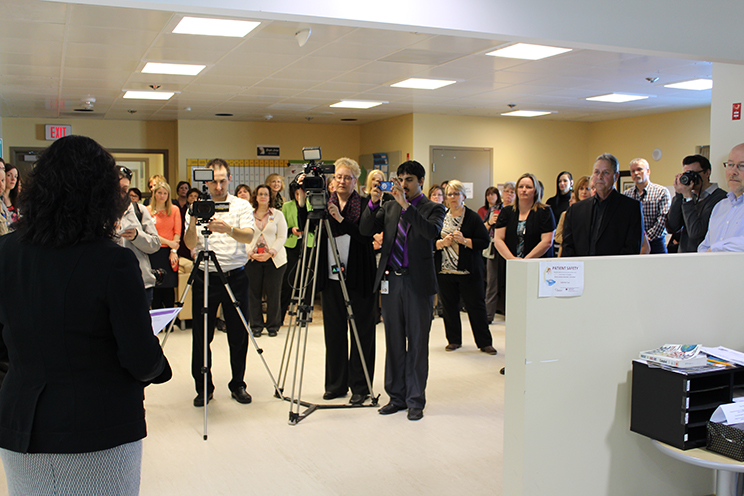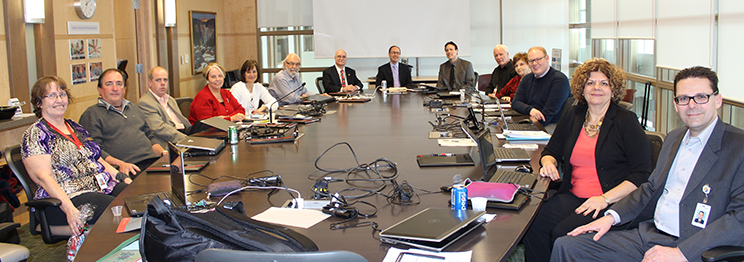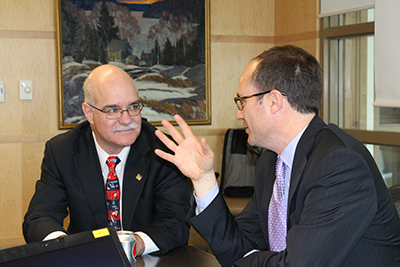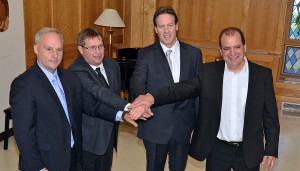The NE LHIN has announced new funding for Northerners who are experiencing mental health and addiction challenges. In total, $4.4 million was announced for projects and services including mental health peer support, care for people with acquired brain injuries, housing support, expanded forensic mental health services for women, and help for parents through the launch of a Northern Ontario Postpartum Mood Disorders Network strategy. Of the announced funding, $3.2 million will go toward developing the new women’s forensic mental health unit here at NBRHC.

Details of the new Forensic Mental Health Service for Women at NBRHC:
The unique needs of women in the forensic mental health system requires the development of a dedicated, highly supported and secure inpatient unit to better respond to specific needs which often involves complex disorders and related challenging behaviours. North Bay Regional Health Centre has been chosen by the Ministry of Health and Long Term Care to develop and operate this specialized intensive treatment, rehabilitation and behavioural management service for the Province which will take into account the differences in the offending, medical and psychiatric profiles of women.
NBRHC will develop and operate an 8-bed forensic mental health service for adult women (18 yrs+) who have been found unfit to stand trial or not criminally responsible due to mental disorder and are subject to Disposition Orders of the Ontario Review Board (ORB) under the Criminal Code of Canada.
The funding announcement also includes $440,000 for a transitional rehabilitation housing program, and $100,000 for behaviour therapy. These two programs are being provided to better serve patients with developmental disabilities and subject to ORB Disposition Orders.
Following the planning and development phase, the new unit will open for patients in approximately 18 to 20 months.
Patients in this unit will stay from 18 months to three years depending on their individualized need and plan of care.
“Women referred to our service will likely have had complicated lives, failed treatments and negative clinical experiences,” said Hélène Philbin Wilkinson, Director, Dual Diagnosis and Mental Health & the Law. “As such, our long term goal will be to foster an internal change process within patients in a trusting therapeutic environment while facilitating continuity of care planning with our referring hospitals. We will work with our partners to gain their input into care decisions about the patient on an on-going basis.”
Paul Heinrich, President and CEO of NBRHC said: “This new highly specialized Provincial level female forensic mental health unit is a testament to the NBRHC team’s reputation for high quality care and demonstrated reliability. In addition, the new community investments will allow some of our long stay mental health patients who require more custodial care with support, to live in an environment more suitable to their well-being, while making hospital beds available for higher level care.”

 Hospitals, with their respective health system partners, have already begun to work together in new models of care to better integrate the services required by their clients and communities, including Local Health Hubs. A Health Hub is a local, integrated health service delivery model where most, if not all sectors of the health system, are formally linked in order to improve patient access.
Hospitals, with their respective health system partners, have already begun to work together in new models of care to better integrate the services required by their clients and communities, including Local Health Hubs. A Health Hub is a local, integrated health service delivery model where most, if not all sectors of the health system, are formally linked in order to improve patient access. She was able to promote how this year NBRHC has embarked on the journey of More Time to Care – a continuous improvement system that empowers people at all levels to remove waste from their work processes to free up time for care and partner with patients and families to help improve patient outcomes.
She was able to promote how this year NBRHC has embarked on the journey of More Time to Care – a continuous improvement system that empowers people at all levels to remove waste from their work processes to free up time for care and partner with patients and families to help improve patient outcomes. “We are combining our efforts and intellect to improve access to care and patient flow across all components of the health system in our community,” said Paul Heinrich, President and CEO of the North Bay Regional Health Centre. “Together we get better at improving the patient, resident and student experience.”
“We are combining our efforts and intellect to improve access to care and patient flow across all components of the health system in our community,” said Paul Heinrich, President and CEO of the North Bay Regional Health Centre. “Together we get better at improving the patient, resident and student experience.” Geden has been the Chairman of the NBRHC Board since April 1, 2011. He was the inaugural board chair of NBRHC and was instrumental in leading the amalgamation of the North Bay General Hospital (NBGH) and the Northeast Mental Health Centre (NEMHC). Geden will remain on the Board as the Chair of the Governance committee.
Geden has been the Chairman of the NBRHC Board since April 1, 2011. He was the inaugural board chair of NBRHC and was instrumental in leading the amalgamation of the North Bay General Hospital (NBGH) and the Northeast Mental Health Centre (NEMHC). Geden will remain on the Board as the Chair of the Governance committee. A special donation was presented at the grand opening. “I am making a gift of $45.00 – 50% of my profits from my classes Young Entrepreneur Program. My classmates and I had to donate 10% to a cause in the community, and I wanted to help kids,” said Nine year old Liam Dreany.
A special donation was presented at the grand opening. “I am making a gift of $45.00 – 50% of my profits from my classes Young Entrepreneur Program. My classmates and I had to donate 10% to a cause in the community, and I wanted to help kids,” said Nine year old Liam Dreany.